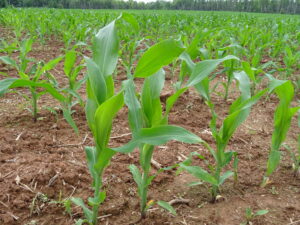Warm Season Crops and Cool Climates
Remarque : cette page web n’est actuellement disponible qu’en anglais.

This article written by Dr. Reynold Bergen, BCRC Science Director, originally appeared in the April 2020 issue of Canadian Cattlemen magazine and is reprinted on the BCRC Blog with permission of the publisher.
According to Statistics Canada, silage corn acreage was 26% higher in 2015-19 than in 2010-14. Most of this increase occurred in the Prairies. Achieving corn’s potential will depend on whether plant breeders can successfully adapt this warm season plant to Canada’s cooler climate.
Plants contain two kinds of carbohydrates. Non-structural carbohydrates are starches and sugars that help the plant store energy and are easily digested by livestock. Structural carbohydrates include the cellulose and hemicellulose fibers found in cell walls. Cellulose and hemicellulose, along with lignin, hold the leaves and stems together and help the plant stand up. Rumen microbes digest hemicellulose more easily than cellulose, but lignin is virtually indigestible. In a feed test, neutral detergent fiber (NDF) measures the amount of cellulose, hemicellulose and lignin. An indicator of “bulk”, high NDF levels limit animal intake. Acid detergent fiber (ADF) is the amount of less digestible cellulose and lignin (but not hemicellulose). Digestibility declines as NDF and ADF increase.
In perennial grasses, cellulose, hemicellulose and lignin levels increase steadily as the plant grows and matures. This makes sense; as the plant gets taller, it requires more structural integrity to keep standing. This is why ADF and NDF increase and digestibility decreases as grasses mature. Non-structural carbohydrates and protein levels rise initially, peak, and decline after grass has headed out. The amount of structural carbohydrate continues to increase as the plant matures and sets seed. That’s why the nutritional value of pasture generally declines as grass matures, and why rotational grazing practices that keep grass vegetative by ‘clipping’ and preventing it from heading out helps maintain the nutritional quality of the pasture later into the growing season.
In contrast, annual crops have been selected for vastly increased grain yield. The amount of structural carbohydrate and lignin still increase as the plant grows and mature. But thanks to millennia of selection for increased seed yield, the percentage of non-structural starch in the whole plant continues to increase after seed set, through kernel filling, before slowing during ripening. For example, research led by the University of Saskatchewan’s Greg Penner (Effect of maturity at harvest for whole-crop barley and oat on dry matter intake, sorting, and digestibility when fed to beef cattle; doi:10.2527/jas2015-0063) found that whole-plant starch content is low at the late milk stage in barley (3%) and oat (2.7%), but much higher in the whole plant at hard dough (25% starch in whole-plant barley, 14.5% in whole-plant oat) and ripe barley (24.6%) and oat (12.8%). These effects are even more pronounced in corn. Nutritive Value of Corn Silage as Affected by Maturity and Mechanical Processing: A Contemporary Review (doi:/10.3168/jds.S0022-0302(99)75540-2) reported that the starch content of whole-plant corn increased from 18.25% (early dent stage) to 28.7% (⅟4 milk line), 37.2% (⅔ milkline) to 37.45% (blackline). In addition to higher starch content, corn also produce 50% greater silage yields than barley – under the right growing conditions.
Corn can produce higher silage yields and starch contents than barley because of a few fundamental differences between the two plants. Because corn is open-pollinated, it is easier to hybridize than self-pollinated barley (as mentioned in the February 2020 column). Barley and corn also use slightly different photosynthetic processes to convert carbon dioxide and water into carbohydrates. Photosynthesis has light and dark stages. During the daytime (light stage), plants absorb energy from sunlight and temporarily accumulate it in energy storage molecules called ATP and NADPH. At night (dark stage), the stored energy is used to convert carbon dioxide and water into structural and non-structural carbohydrates. The majority of the earth’s plant species – including most tame grasses, barley, other small grains, and oilseeds – are ‘cool season’ plants that all use the same dark stage process. A minority are ‘warm season’ plants like corn, sorghum, maize, green foxtail, kochia and blue grama, and use a more energetically efficient dark stage process. That means that warm season plants like corn can put more photosynthetic energy into starch production, plant growth and crop yield than cool season plants like barley. Warm season plants also tolerate heat and moderate drought better than cool season plants. But cool season plants also have advantages. They do better during cool, wet growing seasons and produce more protein than warm season plants.
Much of Canada is suited to cool-season plants, but plant breeding companies have developed corn hybrids that require fewer corn heat units (CHU) during the growing season. The minimum CHU rating for corn hybrids has fallen from 2300 to 2000 over the past 40 years. But corn silage may still be a risky crop. In a cooler-than-average growing season or high elevation, even a low CHU hybrid may not reach the growth stage where starch content adequately offsets structural carbohydrate (NDF and ADF) levels. This would negatively impact silage yields, the ensiling process, palatability and digestibility. The next column will discuss the delicate balance between the higher yield potential of corn and its higher input costs and production risks compared to barley when the growing season is short or unseasonably cool.
The Beef Research Cluster is funded by the Canadian Beef Cattle Check-Off and Agriculture and Agri-Food Canada with additional contributions from provincial beef industry groups and governments to advance research and technology transfer supporting the Canadian beef industry’s vision to be recognized as a preferred supplier of healthy, high quality beef, cattle and genetics.
Click here to subscribe to the BCRC Blog and receive email notifications when new content is posted.
The sharing or reprinting of BCRC Blog articles is typically welcome and encouraged, however this article requires permission of the original publisher.
We welcome your questions, comments and suggestions. Contact us directly or generate public discussion by posting your thoughts below.